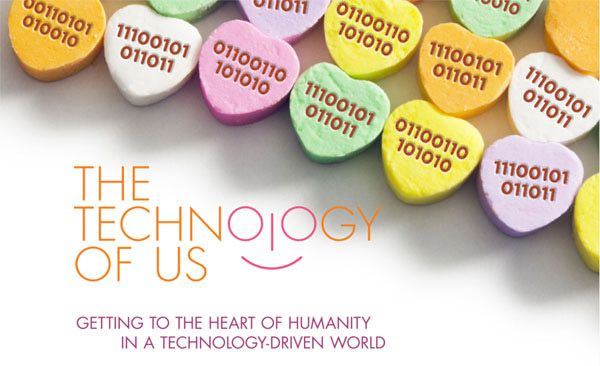If automation was the mantra for technology to date, is humanization the calling for technology in the future? The Technology of Us explores this question from the perspective of top intellectuals, scientists, designers, and business innovators. Its collection of essays and interviews demonstrates how technology is pushing humankind into a new stage of evolution, with as many massive implications for modern business as for our individual lives.
For every leader who aspires to build a truly great company in this new era and who wants a peek at the future of human innovation, this selection of stories will prove to be essential reading. Below are excerpts from the eBook (http://technologyofus.com).
CUSTOMER EXPERIENCE AND US
The Greatest Differentiator: Our Humanity
by Ken Tuchman, CEO, TeleTech
While technology has always been part of our lives, it is now at an inflection point—a point where innovation is happening faster than ever, and its impact on our existence is greater than we’ve ever seen.
Now the question is: What should a business leader do?
The best companies of tomorrow will use technology to create emotional connections with people. They’ll stand for something, act honestly, and do things with a clear purpose. They’ll make great products and services. They’ll be thoughtful in every way. They won’t obfuscate or lie. They will be authentic and reflective. When they make mistakes, they will acknowledge them openly and truthfully and learn from them—publicly, in front of their customers.
Companies that used to use phrases such as, ‘That’s not our policy’ now have an opportunity to say, ‘We can do that. I understand your circumstance and what you’re suggesting makes sense.’ They can learn from customers and can integrate their voices into how their business operates.
They’ll give their employees latitude to respond and they’ll deliver on their promises consistently to build trust. Companies that once looked at growth as True North will need to add the goal of customer love. When they do this, it will redefine how every business decision is made. Should they spend more on television commercials and store leases, or invest in taking the friction out of customer interactions by making them easy, convenient, intuitive, and even fun? Should they keep wasting acquisition dollars trying to fill the leaky bucket or invest in retaining loyal customers who are engaged and promoters of the brand?
Companies in just about every industry today have the opportunity to reinvent themselves. The reinvention can be powered by technology, but it must be led by a true philosophical shift in thinking. Living by company values is no longer a choice but an imperative. When this happens, a whole new generation of companies will emerge and the relationship between business and consumers will never be the same.
It is early days in a new phase of human evolution where the interplay of technology and humanity is creating new kinds of companies and experiences. Not too long ago we took pictures with film, communicated over a landline and kept current by reading the newspaper with our morning cup of coffee. Today, we can accomplish all of these things and much more with a tap of a finger on our mobile device. The Technology of Us is just beginning and I, for one, can’t wait to be a part of what comes next.
A Quantum Leap in Customer Experience
By Eric Ladizinsky, quantum physicist
I often think big—both about artificial intelligence and the future of computing—and I’m firmly optimistic about the future. Why? Artificial intelligence (AI) is essentially any machine that mimics a living and intelligent organism. One day, AI-based devices could help detect and obliterate the first signs of cancer. Or they could pull together the disparate pieces that help us save the biosphere from global warming. I also envision far more prosaic applications for artificial intelligence—ones that will impact every customer-facing business around, from car dealerships to hospitals to judicial systems.
Imagine engaging with a service or sales rep who always knows exactly what you want, whether you’re prone to compromise or argument, or even if you’re tired or happy. This is where the promise of quantum computing comes in.
Quantum computing is based on the principles of quantum physics, and the counterintuitive idea that any particle can exhibit two properties at once. For example, quantum physics holds that a single object can exist simultaneously in two separate places. Classical computers follow linear patterns of 1s or 0s, which means they can make only one calculation at a time. Quantum computing, however, allows a bit of information to operate as a 1, a 0, or something in between simultaneously. Thus, quantum bits can perform exponentially more calculations simultaneously to arrive at an answer faster than any modern computer.
One of quantum computing’s most promising applications as it applies to sales and marketing has to do with inspiration. For companies, understanding the unique factors that motivate each individual customer to engage when she’s happy or sad or tired or curious is pure gold. Our human brains have detectors that signal to us what another person’s tone of voice or body language conveys. Conventional computers can’t do that. But quantum computers will, by virtue of their ability to process hundreds or thousands of variables at once. A customer calls on a Friday afternoon, tired. Imagine machine intelligence that can instantly detect that, listen patiently and help find a solution that works.
Instead of two egos, two sets of preconceived notions or two different moods coming into play, there’s just one human dealing with a machine that’s 100 percent reasonable and fair. That’s the level of interaction—better than human—I want.
----------------------------------------------------
DESIGN AND US
A Higher Calling for Product Design—Emotional Intelligence
By Gadi Amit, creator of the FitBit
As a designer, every day I see how the human side of technology becomes more important to my job. For me, it starts with simplicity.
Yet there’s an unfortunate trend among engineers today to load more onto the product during the design process: more data, more features, and more complexity. When it comes to a user interface, the dominant paradigm is often “the more the better.” As a designer, I believe engineers and designers must focus on simplicity. That requires subtlety—a smaller, cleaner user interface with technological complexity hidden underneath, running quietly in the background.
Simplicity also means a small user interface or no user interface (UI). That approach is what delighted customers when Apple unveiled the first iPod in 2001. The device was stripped to just a few outer functions—play, rewind, forward. There wasn’t even an on/off switch. It was so simple that it didn’t require an owner’s manual. And people loved it. It made sense to them; it understood them. That’s what technology needs to do in order to have an impact.
The tension for designers is to work with multidisciplinary teams of technologists and software developers who don’t always share our understanding of design to create more products like the iPod.
As I design, I try to follow an inner compass that directs me to the best product I can create. With the Fitbit, for example, we adhered to the small UI or no UI approach—designing a wristband that few would know, at first glance, was working behind the scenes to track a person’s steps, distance walked, and calories burned. The Fitbit doesn’t look like your usual fitness gadget; it uses LED lights instead of blips and beeps to measure your fitness progress.
We need to think about how we entice people to adapt and try these new technologies. To do this, designers must create devices built on emotional intelligence.
For technology to move forward, technologists need to accept the leadership of designers, artists and writers, who see the world through a different, more humanistic lens. In the next few years, design’s influence and authority will continue to grow among businesses. Companies that won’t—or don’t—acknowledge this will fade.
We know this not only because Apple succeeded with a design focus, but also because companies that all but ignored design a few years ago—Google and Microsoft for example—embrace it today. They had to. The reality is that certain problems cannot be solved without design, and it is simplicity that lends integrity to the discipline. Leonardo da Vinci put it best more than 500 years ago when he wrote, “Simplicity is the ultimate sophistication.”
Busting Through the Physical Barrier in Digital Design
By Jinha Lee, 3D designer
The power and the potential benefits of our digital technologies are undeniably huge. We are reminded of this every day in almost all aspects of our lives. But we make use of only a portion of the tremendous power of this data.
Here’s the problem: The communication link between humans and the digital tools that surround us is often very small and narrow. It’s typically just the tip of your finger. Touch a screen to enter data. On the other hand, we have all developed great skills to sense and interact with the physical space that surrounds us. Unfortunately, we cannot use most of these innately human skills to work within the digital world. The two-dimensional, flat touch screen, less than a millimeter thick, now divides the two worlds, both physically and metaphorically.
It’s time to think about interfaces that blur the boundaries between the digital and physical space, that engage digital information in physical and spatial forms, drawing on our innate senses to interact with digital information using the full dexterity of our hands, creating a more intuitive, effective and enjoyable experience. One of my research projects, SpaceTop, which I started at Microsoft Applied Sciences Group and MIT Media Lab, looked at this approach. We turned a little space above the keyboard into a 3D digital workspace wherein users can reach in with their hands to manipulate digital objects. Instead of staying away from traditional user interfaces like touch-pads, SpaceTop combines design solutions with this 3D direct interaction, taking advantage of multiple interaction modalities. It is a combination of a transparent display, depth cameras and a new design of desktop hardware that makes it possible for users to manipulate 3D pixels in space with their bare hands. I believe the applications of this will be huge.
The ultimate aim in creating all these sorts of new interfaces is that we lower the barrier for people to access the power of computation. This means that a wider range of people can benefit from it in a bigger context—if we can use a big part of our innate senses and skills to interact with the digital information. Ultimately, such technologies will be simply invisible and become a part of our ordinary lives. The late Mark Weiser, a chief scientist at Xerox PARC, once said: “The most profound technologies are those that disappear. They weave themselves into the fabric of everyday life until they are indistinguishable from it.”
-----------------------------------------------
EDUCATION AND US
The Emerging Power of Visual Literacy
By George Lucas, filmmaker and chairman of Edutopia
[Students] need to understand a new language of expression. The way we are educating is based on 19th-century ideas and methods. Here we are, entering the 21st century, and you look at our schools and ask, “Why are we doing things in this ancient way?” Our system of education is locked in a time capsule.
We must teach communication comprehensively, in all its forms. Today we work with the written or spoken word as the primary form of communication. But we also need to understand the importance of graphics, music and cinema, which are just as powerful and in some ways more deeply intertwined with young people’s culture. We live and work in a visually sophisticated world, so we must be sophisticated in using all the forms of communication, not just the written word.
When people talk to me about the digital divide, I think of it not being so much about who has access to what technology as who knows how to create and express themselves in this new language of the screen. If students aren’t taught the language of sound and images, shouldn’t they be considered as illiterate as if they left college without being able to read or write?
Unfortunately, most learning institutions find that idea very difficult to swallow. They consider the various forms of unwritten communication as some type of therapy or art, something that is not relevant to the everyday life of a student. This is wrong.
You can measure verbal or math skills by determining whether a student is right or wrong on a test—in other words, whether they’re learning or not. With visual communication, some might argue it’s trickier to measure progress and competency.
But there are rules for telling a story visually that are just as important as grammatical rules or math terms, and you can test people on them as well. There is grammar in film, there is grammar in graphics, there is grammar in music, just like there are rules in math that can be taught. For instance, what emotion does the color red convey? What about blue? What does a straight line mean? How about a diagonal line?
We need to look at the whole world of communication in a more complete way. We need to take art and music out of “the arts class” and put it into the English class. For instance, the various forms of communication form a circle. On one point of this circle is math, the least emotional of all forms of communication. It’s very strict and very concise, and has a very precise way of explaining something. Then you start moving around the circle and you get to the opposite side, where we have music, which primarily appeals to your emotions, not to your intellect.
So, in this great circle of communication, you go from the emotional end of music and painting and art—the visual forms of communication—to the written communication and spoken communication. Finally, you end up at math, which is the most precise. It forms a beautiful circle of communication. But it’s all part of the same circle.
Unbundling Education
By Don Tapscott, author of The Digital Economy
When I earned my first graduate degree in the 1970s,
I figured I was set for life. That’s what my generation—and those since the dawn of the Industrial Age—had been taught: first K–12, then college and, to really lock in my long-term value in the job market, graduate school for a specialty degree. Today’s workers don’t have that luxury. Even graduates of the world’s most prestigious programs can consider themselves set for about 15 minutes.
I exaggerate, but only to emphasize the fact that the skills we learn today are often obsolete tomorrow. Technology is moving at such speeds that the only way knowledge workers of the future will be able to stay competitive is by continuously learning and updating their skills throughout their lives. There’s already a lot of hand-wringing over the “skills gap,” the huge divide between the skills job seekers have and the skills employers today are looking for, but that’s only going to widen unless educators, employers and workers come together to build a new model for lifelong learning.
Lifelong learning can’t happen within our current education model.
Under this new technology-enabled model, future workers won’t spend late nights at the library memorizing facts, theorems, or philosophies. Instead they’ll learn how to think, how to solve problems, how to collaborate and how to communicate with others. Those skills—which also require an innate desire to learn—is what will make workers of the future employable and give employers the critical thinking they need to compete.
When I think of today’s system of higher education, I can’t help but think of milk cartons and their timestamps. Just as milk goes sour and needs to be replaced, so too does the knowledge base of today’s workforce. Careers must be reinvented over and over in order for workers to stay relevant and for employers to thrive.
The rise of the networking age is allowing workers and others to tap into the crania of other people to learn more.
The education system of the future doesn’t spell the end of Ivy League schools or gowns with tassels after a few years of instruction. Post-secondary school training will always be a necessity. By 2020, an estimated 63 percent of the projected 48 million job openings in the United States will require at least a college degree. A physical campus will always be necessary so future workers can experience the kind of social learning that only happens face-to-face. But what we won’t see is the Industrial Age model of one teacher lecturing an auditorium filled with college freshmen on the basics of supply and demand or quantum mechanics. Teachers will become much more than just transmitters of information. They will become curators of learning experiences; they will facilitate small group discussions and debates aimed at teaching critical thought, problem solving, collaboration and communication.
In this future model, workers will be more responsible for their own education, and employers will take on a bigger role in providing their workers with the skills they need.






